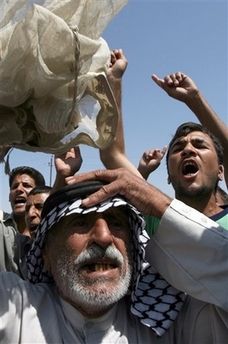 BAGHDAD: Five years after US and British forces swept into Iraq and toppled Saddam Hussein, many Iraqis are asking if the violence and upheaval that turned their lives upside down was worth it.
BAGHDAD: Five years after US and British forces swept into Iraq and toppled Saddam Hussein, many Iraqis are asking if the violence and upheaval that turned their lives upside down was worth it.The human cost is staggering - anywhere between 90,000 and 1 million Iraqi civilians killed, according to various estimates. Nearly 4,000 US soldiers have been killed while 4 million Iraqis have been displaced. On the bright side, Iraqis are rid of one of the 20th century’s most ruthless dictators. They held free elections and have a new constitution. For Iraqis, deciding if the invasion was worth the sacrifice depends partly on their sect and ethnicity and where they live.
Saddam, a Sunni Arab, persecuted the country’s majority Shias and Kurds. Shias now hold the reins of power while once-dominant Sunni Arabs have become marginalised. In Baghdad, the epicentre of a sectarian war in 2006 and 2007 that nearly tore Iraq apart, people long for the safe streets of Saddam’s era. In the Shia south, they no longer fear Saddam’s henchmen, but rival Shia factions competing for influence. In the north, the economy of largely autonomous Kurdistan is flourishing in a region that Kurds call “the other Iraq”.
Foreign Minister Hoshiyar Zebari, a Kurd, said Iraq was moving in the right direction. “Those who felt the invasion was a mistake should remember Saddam’s atrocities,” he said, adding, “Proof that a majority of Iraqis supported the overthrow of Saddam was their participation in 2005 elections. The brutality of Saddam’s regime deformed society in many ways so we have to be patient.” He said, “Compared to the experience of other nations, I think we have done very well. But yes, it has been very, very costly.”
Um Khalid, a 40-year old Baghdad hairdresser, said violence was so random that no one knew if they would be the next victims. “No, no, no. What happened was not worth it. Those who say things are better are lying,” she said. Many Iraqis vividly recall the chaotic months after the invasion on March 20, 2003, symbolised by the toppling of a big statue of Saddam in central Baghdad. Their euphoria at new freedoms and hopes the United States would transform Iraq into another rich Gulf Arab state were dashed as Sunni Arabs rose up against their new rulers and car bombs turned markets and mosques into killing fields.
In February 2006, suspected Al Qaeda militants blew up a revered Shia mosque in the town of Samarra, unleashing a wave of sectarian violence that meant being a Shia or a Sunni in the wrong neighbourhood could be a death sentence. “Before 2003, we lived under a tough regime, no one can deny that,” said Abu Wasan, 55, a former army brigadier-general and a senior member of Saddam’s disbanded Baath party. reuters
http://www.dailytimes.com.pk/default.asp?page=2008\story_12-3-2008_pg4_10


No comments:
Post a Comment